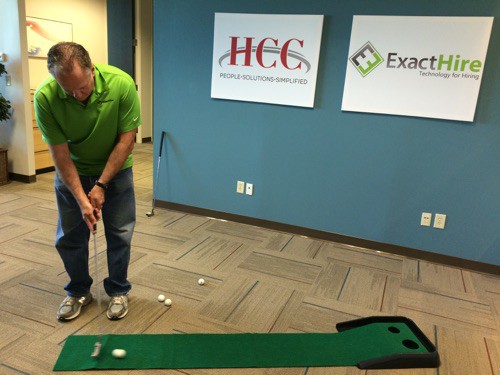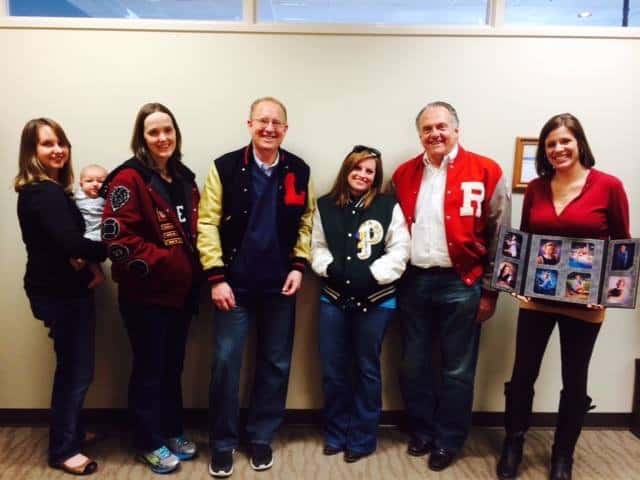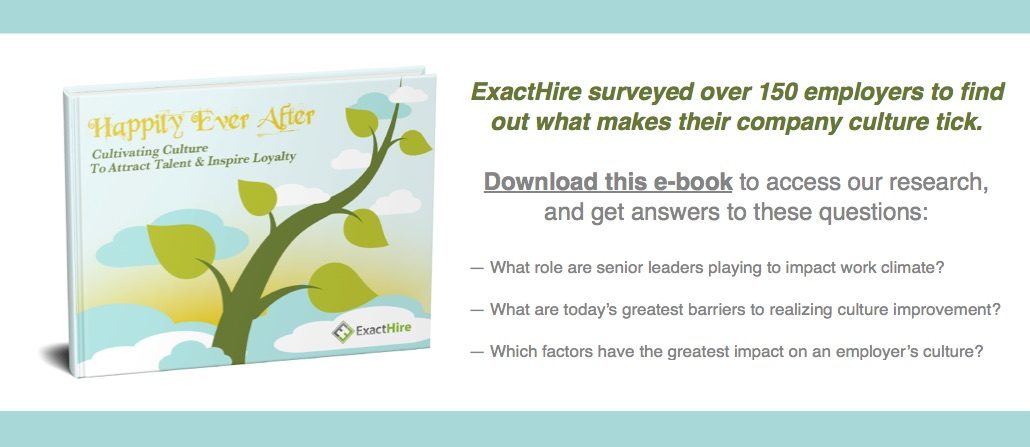33 Fall Employee Engagement and Culture Ideas
Pumpkin spice season is here, folks, and that means my favorite time of year is upon us–fall. So many good things happen in the autumn:
- beautiful fall foliage (at least in the Midwest where ExactHire calls home),
- tailgating for your favorite sporting events like football and futbol (for all you soccer moms like me out there),
- new fall TV show premieres, and
- an early start to the excitement of the holiday season (and more frequent chances to be thankful and celebrate life with friends and family).
At least a few of the ExactHire employees love to celebrate the season, too. Can you tell? Did you know an ATS is a great way to develop and create a strong work culture, through finding good quality candidates? If you want to find out more, check out our Free ATS Guide!

Hey, we worked hard to capture the leaves in motion for this shot!
The activities our “Fun” Committee plans are great ways to break up the work week and give us more chances to connect with each other. Opportunities for connection are increasingly important for employers in today’s web-based workplace and society.
In this blog, I’ll present ideas for using the autumnal season to inspire ideas for employee engagement.
1 – Pick a day each fall month for competition and snacks
It’s easy to let time get away from you when it comes to planning culture-building activities frequently enough. Have a recurring “funday” appointment on your office calendar, and then fill in with surprise one-off activities as appropriate.
ExactHire has Monday Funday the third Monday of every month following our all-hands company meeting. In September, we honored various pro golf championship tournaments with a little putt-putt of our own. Of course the winner, our Co-Founder Harlan Schafir, was able to claim our super classy brass vase (make sure you pronounce it vahzzz to sound fancy). The giant cookies being served didn’t hurt employee attendance to this event, either!

Our Co-Founder, Harlan Schafir, putts for the Monday Funday win!
2 – Roast some office s’mores
Don’t try this one inside, friends…unless you opt to use the microwave or remember to blow out your candle afterward. But let’s be honest, a candle probably won’t get the job done. Lucky for you, mini kitchen blow torches are reasonably affordable.
3 – Have a pumpkin decorating contest
Whether you carve, paint or decorate, procure some pumpkins for all employees willing to participate. Have a small prize, display them in your office (make sure to take pictures!) and then encourage employees to take them home to friends and family.

Employee entries from our fierce pumpkin decorating contest last October.
4 – Volunteer for a worthy cause
As the weather starts to cool (depending on where you live), many non-profit organizations, including shelters, will have a greater need for assistance and resources to help individuals fend off the elements. Organize a team or department to take time to serve in a capacity that will assist the recipient organization.
5 – Have a dance party
Does anyone really do that? Yes, I’ve worked for employers who did this periodically to destress employees. Take requests and then put a season-inspired song on the phone system intercom. Here are some tune ideas to get you started:
- “Thriller” by Michael Jackson (go ahead, channel Jennifer Garner in “13 Going on 30”),
- “Dead Man’s Party” by Oingo Boingo,
- “Toxic” by Britney Spears,
- “The Devil Went Down to Georgia” by The Charlie Daniels Band, and
- “Time Warp” from The Rocky Horror Picture Show.
6 – Stock the kitchen with fancy coffee creamer
Whether it’s artisanal or just the latest Coffee Mate creation, having access to creamer flavors like pumpkin spice, eggnog, spiced latte and peppermint will perk up anyone’s morning brew.

Image credit: coffee lover
7 – Sponsor an employee team for a 5K
Five-kilometer races abound in the fall in our area. Select a race that benefits a notable cause and sponsor a team of employees who enjoy jogging and walking. Go the extra mile and have a t-shirt design competition, and then produce the winning shirt for all team members to wear during the race.
8 – Board game breaks
Don’t stop at puzzles, schedule occasional “game days” when employees get the chance to spend an hour facing off against other employees to win a game. Hint: Don’t pick Risk–it takes forever! Twister would be a good one to avoid, too. Fun, but relatively short, options might include
- Uno,
- Jenga,
- Qwirkle,
- Rummikub, and
- Euchre.
9 – Make caramel apples
If you don’t want to unwrap little caramel candies or don’t have access to a stove in the office, then keep it simple with incredibly convenient caramel apple wraps.
10 – Celebrate Oktoberfest
Whether you go with a full-on German fare-inspired pitch-in or keep it simple with some Bavarian pretzels and a beer tasting, you can’t go wrong with food. Encourage any employees who are brewing and/or sausage-making hobbyists to bring in their own creations to share.
11 – Feast at a festival
The fall is a time for bountiful community festivals. Here in Indiana, the Covered Bridge Festival is a multi-day, multi-town event that combines crafts, cuisine and crowds into an explosion of autumn sentiment. I never miss it. Check your state festival guide to see if any local events would make a great extended lunch destination for your crew.
12 – Conduct meetings outdoors
Does your building have a patio space, or even a few picnic tables? If so, unplug the laptop and head outside for a group meeting or a 1-on-1 discussion. Employees will relish the fresh air and everyone can soak up some extra vitamin D.

Image credit: Picnic Table
13 – Go on a scavenger hunt outside
Plan an autumn scavenger hunt as a team-building activity and friendly competition. A recent chaperone experience I had with my son’s class field trip taught me that empty egg cartons make great containers for small scavenger hunt items. Or, if you want to go a more tech-savvy route, have participants share proof of accomplishing hunt challenges by tagging your corporate Instagram account (a great tactic for employment branding).

Handy container for collecting fall scavenger hunt items
14 – Plan a spirit week
If you enjoyed dressing up for spirit week during homecoming in high school, then you’re bound to be amused by participating in themed days in the workplace. Solicit employee ideas for themes and consider awarding small prizes each day. Our team had fun with high school day in the past when we showed off our letter jackets, senior portraits and yearbooks.

Some EH’ers showing off our high school memorabilia.
15 – Have a potluck tailgate
Set up a grill in the parking lot and have employees pitch in by bringing tailgate-themed dishes. Depending on the date and time of the event, consider streaming a favorite sporting event for all to watch while eating. Don’t forget to have everyone wear their favorite jersey, and have a drawing to win a couple of tickets to a college or pro sporting event.
16 – Make some microwave caramel corn
Growing up, the only way I’d eat caramel corn was if it was made in a brown paper bag in the microwave. There’s something about that warm, gooey deliciousness that puts it near the top of my comfort food list. The best part about it is that it is easy to clean up after your office teammates dig into it. Just fold up the bag and toss it in the garbage.
17 – Nerf gun turkey shoot
Looking for inspiration for silly office games? Look no further. Gather up a few Nerf guns from employees’ children, and set up bowling pin-style targets that complement the season on a conference room table. Go for turkeys, pumpkins, ghosts or leaves.

All set with turkey targets in place!
18 – Produce a Thanksgiving card or video
This is one of my favorite ExactHire traditions. Instead of sending a winter holiday card to clients, we always send a Thanksgiving note. In the beginning, we sent cards in the mail, but then we transitioned to a collaborative video production to show thanks. We can’t wait to put one together for this year, too! If you’re nervous about getting started with this kind of project, we have some video production tips for you.

Wicked witch legs on a previous ExactHire Halloween work day.
19 – Have a costume contest
What would a fall activity list be without a reference to Halloween costumes? Incentivize employee participation with kooky prize categories such as
- best homemade costume,
- most tech-savvy costume,
- best unconventional materials costume (yes, I’m channeling Project Runway), and
- best pop culture-inspired costume.
20 – Take a group trip to pick apples
Go on an outing to gather up ingredients for some red hot applesauce (a favorite from my childhood) or apple dumplings.
Image credit: Time well spent




